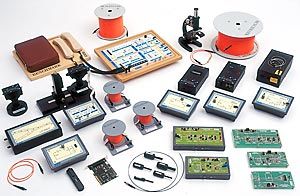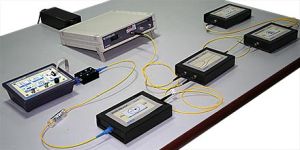
OTDR Training System
The Experimental OTDR setup consists of individual modules in a vision to provide for the users to gain knowledge on the building blocks of Experimental OTDR and also enhances them to conduct various other experiments separately. The OTDR set up trains the user on OTDR operation, at fraction of a commercial OTDR cost. The user configures the OTDR and works with several fibre events provided. The manual explains the concepts, the functionality of different blocks, different experiments and the commercial applications. Modular fibre events with connector and adaptor at various distances are part of the lab to work with experimental OTDR. Other events can be added on request to capture the fibre bending effect, splice loss etc.
...more
OPTICAL FIBRE TRAINING SYSTEM
The Benchmark OFS IV – the latest in the Benchmark series of Optifical Fibre Training Systems – is designed to provide comprehensive training to students and all levels of scientific and technical personnel on fibre optic devices and digital communication systems. The laboratory spans fibre optics and related topics, including: Fibre optic device characteristics Principles of fibre optics and digital communications Fibre optic equipment Digital and analog fibre optic links The OFS IV can be used for demonstration, training and experimentation and, can form the basis, for student and research projects and prototypes. In short, the Benchmark Optical Fibre Training System – OFS IV – ensures that its users will be well-equipped to work with large-scale, real-world fibre optic systems. Features The OFS IV Sytem comprises compatible fibre optics equipment and components to conduct a series of structured experiments OFT- Optical Fibre and Digital Communications Trainer demonstrates integrated voice/data communication link, TDM and digital communication principles. It offers unlimited experimentation using on-kit circuitry and external interfaces, including an RS-232 add-on Demonstration & Measurement of multimode fibre characteristics – Bending Losses, Attenuation, Pulse Broadening, Numerical Aperture, Clad mode stripping study Individual LED, LASER, PD and APD Modules for device characteristics study. The characteristics modules cover forward, reverse & zero bias, leakage characteristics Experimental OTDR: Integrate essential blocks of an OTDR and understand its principles of operation Learn how to use an OTDR with fabricated fibre events Plastic and glass fibre links - for experimentation and as interface modules for other digital circuitry Light Source with variable optical power output, continuous wave, external modulation, internal word and PRBS generation Power Meter calibrated at 650, 850 & 1300nm Specially designed component-insertion PCBs for link construction – for repeated use by students Comprehensive lab manuals for individual modules. The manuals cover the theory and guide students through a series of experiments Optional Connectorisation and Splicing Kits – to provide students with hands-on experience in connectorisation and splicing of glass fibre Optional range of LEDs, detectors, fibres, connectors, adaptors & receptacles – for custom-development of links, and for study of fibre optic devices and fibre-handling Optional Single Mode Fiber Characteristics Study – Modes observation, Normalized Frequency (V-number) calculation, Mode Field Diameter & NA Measurement.
...more
Optical Power Meter
Benchmark Hand-held Fibre Optic source FOPS for fibre optic test and measurement can be used to measure attenuation in optical fibre cables, connector and splicing losses and to characterize optical attenuators, directional couplers, photodetectors, etc. The FOPS -101 uses a stabilized high speed GaAs infrared LED emitting at 880nm.The typical power coupled into 50/125μ Graded Index (GI) fibre with numerical aperture (NA) of 0.2 by FOPS is –20dBm. This optical power can be varied down to approximately 5dB range. The bit rate can be set to one of 64, 128, 256, 1024 and 2048 Kbps. The equipment operates in three modes, viz. Internal (INT), External (EXT) and Continuous wave. Benchmark Hand-held Fibre Optic power meter FOPM - 101 for the wavelength range 600nm & 850nm uses a large area Silicon Photodetector as sensor. FOPM - 102 for the wavelength range 850nm to 1550nm uses a large area Germanium photodetector as sensor. The FOPM - 101 power meter has been calibrated at 850nm and FOPM - 102 power meter has been calibrated for 850nm, 1300nm and 1550nm and the calibration wavelength is switch selectable. It can measure optical power from –60dBm (1nW) to +3 dBm (2mW). A three and half digit LCD display provides a direct readout in dBm, with a resolution of 0.1 dB. The power meter is provided with universal adaptor with ST interface. It allows the measurement of optical power even at high bit rates as it reads the average power.
Display Type : :
...more
fibre optics
Fibre Optics have revolutionised the way the world communicates today. Optical fibre based communications systems are working today in the Telecom, Railways, Defence, Industrial Automation and Medical industries or sectors. Fibre optic training has, therefore, assumed great importance in this scenario of widespread usage of fibre optic technology. Potential entrants into this technological field have to be well versed and equipped to work with large-scale, real world, fibre optic systems. In order to train these potential entrants effectively, it becomes critical to set up "state-of-the-art" equipped labs at reasonable costs. A task that gets further compounded when one weighs in the various permutations and combinations that setting up such a fibre optic laboratory entails. For, apart from having to identify the required equipment and components, one has to ensure perfect compatibility between components, availability of spares and replenishments, expandability and the sourcing of all this, most often, from multiple vendors – all to be achieved within a limited budget. Finally, at the end of this this difficult exercise there is still no guarantee of full compatibility, support or even cost effectiveness. This is where Benchmark Electronic Systems steps in. Benchmark provides a complete single-source solution to all the above parameters or aggravations. It offers a complete range of products and spares, starting from individual Optical Fibre Trainers to versatile and comprehensive Optical Fibre Laboratory Systems. A product range that encompasses a comprehensive list of accessories from cables to links and connectors, power sources to power meters... all guaranteed to be not just compatible but completely upgradeable. And backed by a range of options for training personnel / students in optical fibre concepts and practices. Benchmark, in fact, guarantees that students can start working in the laboratory right from the day one.
...more
EDFA Training System
The Benchmark ETS is an EDFA (Erbium Doped Fibre Amplifier) Training System. Erbium Doped Fibre Amplifier (EDFA) is an optical amplifier that amplifies optical signals sufficiently enough to cover several tens of kilometers without any need for conventional repeaters. Moreover, as it works in the same optical domain, it avoids the need for several stages of signal conversion with their associated problems. Consequently, EDFA finds extensive use in the fibre backbone. The Benchmark ETS – EDFA Training System – addresses the need for a training setup that shows the building blocks of a typical EDFA as well as the characteristics of such blocks. All the blocks are given with proper input and output connections such that they can be configured in different modes of operation, such as co-directional and counter-directional operations. This modular approach also facilitates study of individual block characteristics wherever possible.
...moreBe first to Rate
Rate ThisOpening Hours